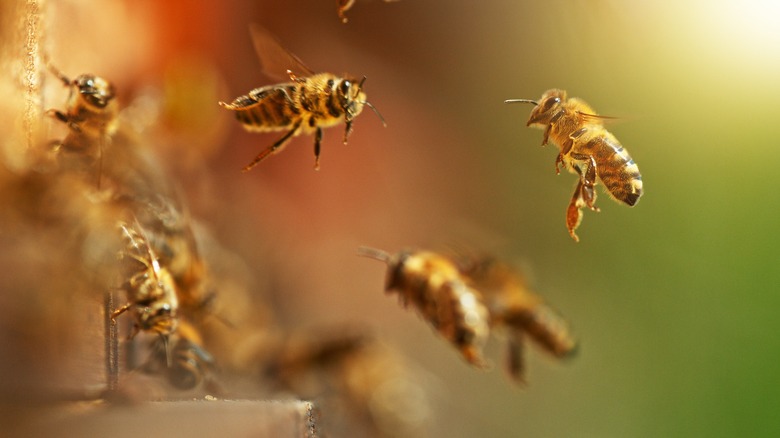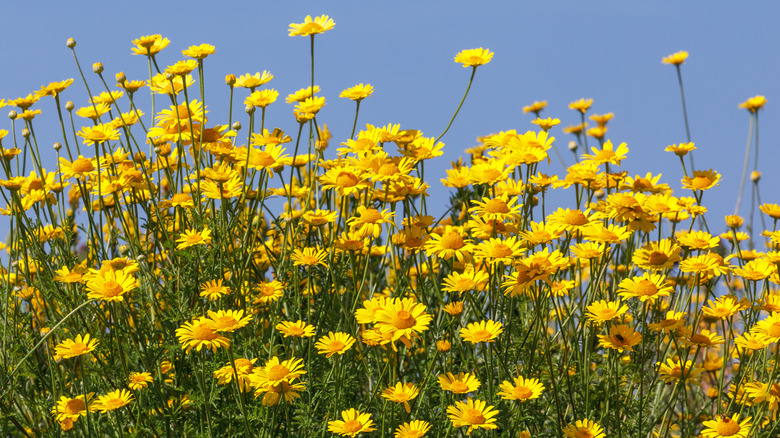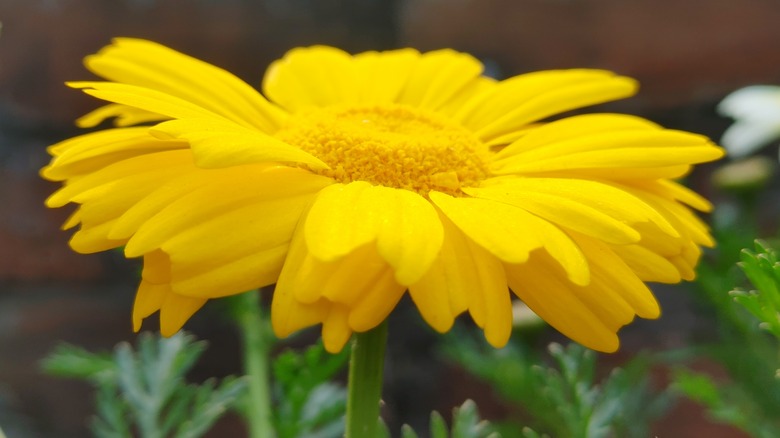Attract Beneficial Insects To Your Yard With This Daisy-Like Perennial Herb
Most plants in your garden attract some type of pests, but drawing in the best bugs to protect your garden — those that pollinate the flora and protect it from infestations — takes a bit more planning. The golden marguerite (also known as dyer's chamomile and Anthemis tinctoria) makes this job a breeze. The golden-bloomed perennials look much like common daisies but with egg-yolk yellow petals. And, like daisies, they're a magnet for bees and other useful insects thanks to their nectar- and pollen-laden blooms. As an added benefit, these marguerites have ample ornamental value. Their rich, yellow color makes an accent in your yard but also pairs (and contrasts) well with other blooms.
Golden marguerites thrive in USDA hardiness zones 3 through 7. This means you can grow them without much trouble if you live anywhere in the contiguous United States apart from the coldest reaches of the Midwest and the hottest Southern states. These are hardy plants that need precious little to stay happy, so the toughest part of growing them may just be staying out of their way.
Where to plant golden marguerite in your garden
When planting the golden marguerite in your garden, consider the location. On the one hand, you want to take advantage of these flowers' unique golden color to accent your garden. On the other hand, these flowers will attract insects to your property. A carefully chosen spot will provide a healthy habitat for the plants, add color to your yard, and create an appealing spot for insects. Golden marguerites love spots that offer full sun, as do beneficial insects like bees. That said, the location shouldn't be too windy, as strong gusts will keep insect visitors away.
A patch of golden marguerites may look stunning on its own, but you'll achieve an even more vibrant aesthetic (and attract more bees!) by growing them with other colorful flowers. Some suitable companion plants for the golden marguerite include Russian sage and ornamental onion (Allium). All of these plants thrive in the same lighting conditions, have similar irrigation needs, and tolerate diverse soil types. Both Russian sage and allium invite pollinators with their blooms, too. Meanwhile, lavender is a possible companion whose purple petals create a powerful contrast against the marguerites' rich yellow blooms. That said, lavender is less hardy than Russian sage and allium and won't adapt to different soil types as well as marguerites.
How to care for the golden marguerite
Golden marguerites require little care. As long as you satisfy their lighting and soil needs, all these flowers ask is that you leave them alone. Crucially, the marguerites are happiest in full sun. You don't need to water mature plants since they prefer dry soil and get by on rainwater alone. Even then, don't allow rainwater to collect around their roots — the soil should drain quickly and effectively. The golden marguerite prefers poor soils, so don't fertilize too much. Soils that are too rich in fertilizer will cause the stems to grow tall and lose stability. When the flowers die, you can deadhead to encourage new blooms to emerge. Dividing the clumps once every few years will also help keep the plant healthy.
Butterflies and bees aren't the only creatures drawn to golden marguerites — slugs and aphids often infest these plants as well. You may be tempted to ward off these pests with appropriate treatments, but beware: Chemical repellents will interfere with your plan to attract beneficial insects. To avoid harming the entire ecosystem that develops around your golden daisies, consider using eco-friendly methods to keep pests at bay.


